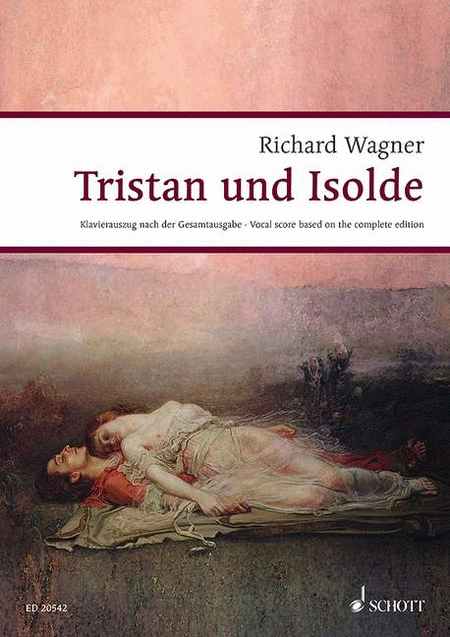3 (3. auch Picc.) · 2 · Engl. Hr. · 2 · Bassklar. · 3 - 4 · 3 · 3 · 1 - P. S. (Trgl. · Bck.) - Hfe. - Str. Auf der Bühne: Engl. Hr. · 6 Hr. · 3 Trp. · 3 Pos. - Digital Download SKU: S9.Q17773 Handlung in drei Aufzügen. Composed by Richard Wagner. This edition: vocal/piano score. Initial release - Opera - theater. Wagner Urtext Piano/Vocal Scores. Downloadable, Piano reduction. Duration 270' 0. Schott Music - Digital #Q17773. Published by Schott Music - Digital (S9.Q17773). German.An important addition to the newly produced orchestral materials by Schott Music is the fi rst publication of vocal scores of Richard Wagnerâs ten great operas in every important version. For the first time, we are able to offer theatres and interested opera-lovers vocal scores as urtext editions conceived following uniform editorial criteria: * The score corresponds to the performance materials from the Complete Edition. * For practical use in rehearsal and study, every vocal score includes rehearsal cues and bar numbers throughout. * The publisher has secured the services of renowned musicologists associated with the Richard Wagner Complete Edition who convey detailed information in critical forewords. * The forewords are given in three languages (German, English, French). * Uniform and attractive front cover designs with reproductions of paintings from the Wagner era underline the series design of the edition. TRISTAN UND ISOLDE Performance directions by the singer Ludwig Schnorr von Carolsfeld are incorporated in the vocal score from the Complete Editionâs Tristan und Isolde volume. He entered these directions into his own copy of the Tristan part which he used at the 1865 Munich premiere. Richard Wagner was deeply impressed by his interpretation of the title role. For the first time in a vocal score of Tristan und Isolde all cuts are incorporatedâwith the corresponding transitional barsâwhich Wagner himself made, and approved, in two cases, were actually declared by him to be final. These cuts strikingly document Wagnerâs struggle with the final form of the work. For the first time in a single edition all of Wagnerâs own suggestions for ossias are found; ossias which evolved from performances under his own direction. Egon Voss writes about this in his foreword to the vocal score: âSuch âpointersâ, as you might say, were current practice in the 19th century which Wagner, as the example shows, did not evade. He was enough of a practical man of the theatre to know that a badly sung top note is worse than doing without it. Wagner even tolerated the transposition of lengthier passages because he was less concerned with the letter of the score than with theatrical effectiveness. [...] The present vocal score goes beyond the Complete Edition [...] in that the ossias mentioned above are indicated in the vocal part itself, in small notes. They concern principally the role of Tristan, but also those of Isolde, Brangäne and Kurwenal. They rest in part on the Tristan edition within the Complete Edition but for the greater part go back to a source which could not be consulted for the Complete Edition because it was not yet accessible. This relates to a vocal score from the estate of the composer Peter Cornelius who was engaged by Wagner as repetiteur at the Vienna rehearsals in 1861-63. That the ossia bars go back to Wagner can be taken as certain, since in some places they are notated in his own hand.â (Egon Voss, quoted from the foreword to the vocal score) The transpositions mentioned by Egon Vossâtwo by Hans von Bülow for the revival of the work which he conducted in Munich in 1869 and the third suggested by Wagner himself in 1861âare printed in the appendix to the vocal score. The ossias, transpositions, and cuts are available for practical use in the theatre and in rehearsal. The cuts are also incorporated into the orchestral materials for Tristan und Isolde. This is also the case with ossias which affect the orchestral parts.2013 marks Wagnerâs bicentenary, making the year largely focused on his music, particularly the dramatic works. An important addition to the newly produced orchestral materials by Schott Music. The score corresponds to the performance materials from the Complete Edition. Schott Music have secured the services of renowned musicologists associated with the Richard Wagner Complete Edition who convey detailed information in critical forewords. For the first time, this work is available to theatres and interested opera-lovers as urtext editions. For practical use in rehearsal and study, every vocal score includes rehearsal cues and bar numbers throughout. The forewords are given in three languages (German, English, and French). Other vocal scores available: Der fliegende Holländer (1841) Der fliegende Holländer (1842-80) Tannhäuser Lohengrin Das Rheingold Die Walküre Siegfried Götterdämmerung Die Meistersinger von Nürnberg Parsifal.
